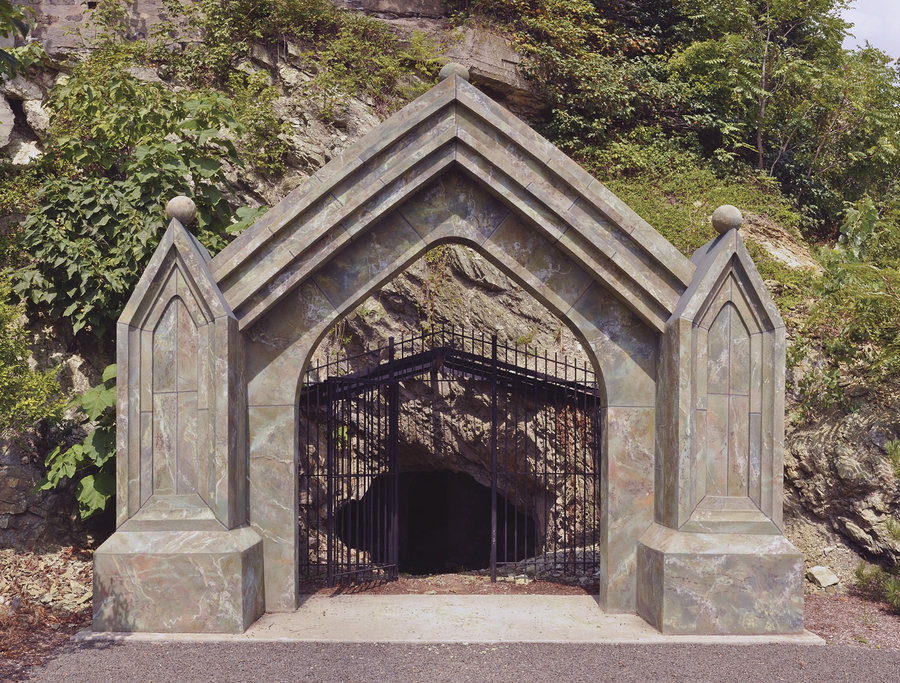Sybil’s Cave, a natural spring carved into the base of the greenish stone bluff known as Castle Point, is one of Hoboken’s best-known landmarks. Anybody who wants to can view its locked entrance on Sinatra Drive. And though much has been written about it, a lot of folks are wondering, what’s its current status? Will it ever be open to the public?
The cave, which was excavated around 1832 by Hoboken’s founder, Col. John Stevens III, and adorned with a gothic-style stone arch, was originally Hoboken’s biggest tourist attraction, for the magnesium-laced water that flowed from a natural spring inside. From the mid- to late-1800s, thousands of glasses were sold daily at a penny apiece to visiting New Yorkers, who took Stevens’s ferry to the bucolic getaway of Hoboken, for the famed water, the beautiful River Walk, and to watch cricket and baseball on the Elysian Fields.
Sybil’s Cave was named after the ancient prophetesses devoted to various Greco-Roman gods and rumored to possess divine wisdom, while the Elysian Fields alludes to the area of the underworld reserved for the virtuous and heroic.
In 1841, Sybil’s Cave made national news when the body of a beautiful young cigar-shop worker, Mary Cecilia Rogers, washed ashore nearby. The incident inspired Edgar Allan Poe’s The Mystery of Marie Rogêt, one of the first true-crime detective novels.
Sybil’s Cave was rediscovered in 2004 by developers Daniel Gans and George Vallone, working with Hoboken Historical Museum director Bob Foster and then-Mayor David Roberts. In 2007-2008, the cave was carefully cleared of rubble and debris, and a new decorative arch, reminiscent of the original stone arch, was placed at the entrance, with a small landscaped park.
In 2009, the Hoboken Historical Museum secured a grant from the New Jersey Historical Trust to hire archaeological historian Lauren J. Cook to perform an assessment of Sybil’s Cave and research its history. His research indicates the cave may have been originally excavated as part of an exploratory mine, since the Stevens family owned mining interests elsewhere in the state. His full report is published on the museum’s website. (www.hobokenmuseum.org/self-guided-walking-tours/sybils-cave-history).
According to Cook’s survey, the cave’s entrance today measures 8.83 feet wide at the floor and 5.5 feet high. Traces of brickwork, probably from the entrance arch, are found at the east side of the entrance. The interior floor of the cave measures 20 feet by 17 feet. The ceiling is four-and-a-half to five-and-a-half feet, and there are four columns near the center of the cave, surrounding a cistern of about 2.4 feet by 2.6 feet carved into the floor. This reservoir reportedly collected groundwater that filters into the cave through cracks in the bedrock, and appears to be permanently filled with water. An arch has been carved into the bedrock above and between the two columns closest to the entrance, echoing the arch that formerly stood outside the cave’s entrance.
Cheers
Sybil’s Cave was closed at some point in 1880, due to health-department concerns about water quality. A heavy iron door was placed across the entrance, and the cave was used as a cool storage locker for a nearby eating and drinking establishment, opened in the 1880s by Fred Eckstein. The restaurant eventually devolved into a seedy waterfront tavern, and finally closed in the 1930s, when the cave was filled in with dirt, concrete, and rock fragments.
Today, the exterior gate to the park is generally open 24 hours a day. In nice weather, folks can enjoy a picnic lunch on tables with benches, but the gate to the actual cave is locked. The water was tested and found to contain too many impurities to be drinkable, and the interior is rocky and slippery. Currently, there are no plans to open the cave on a regular basis. But you can visit Sybil’s Cave virtually, via the Museum’s website, where a 360-degree, high-resolution image has been archived through Gigapan technology. Happy virtual spelunking!—07030
